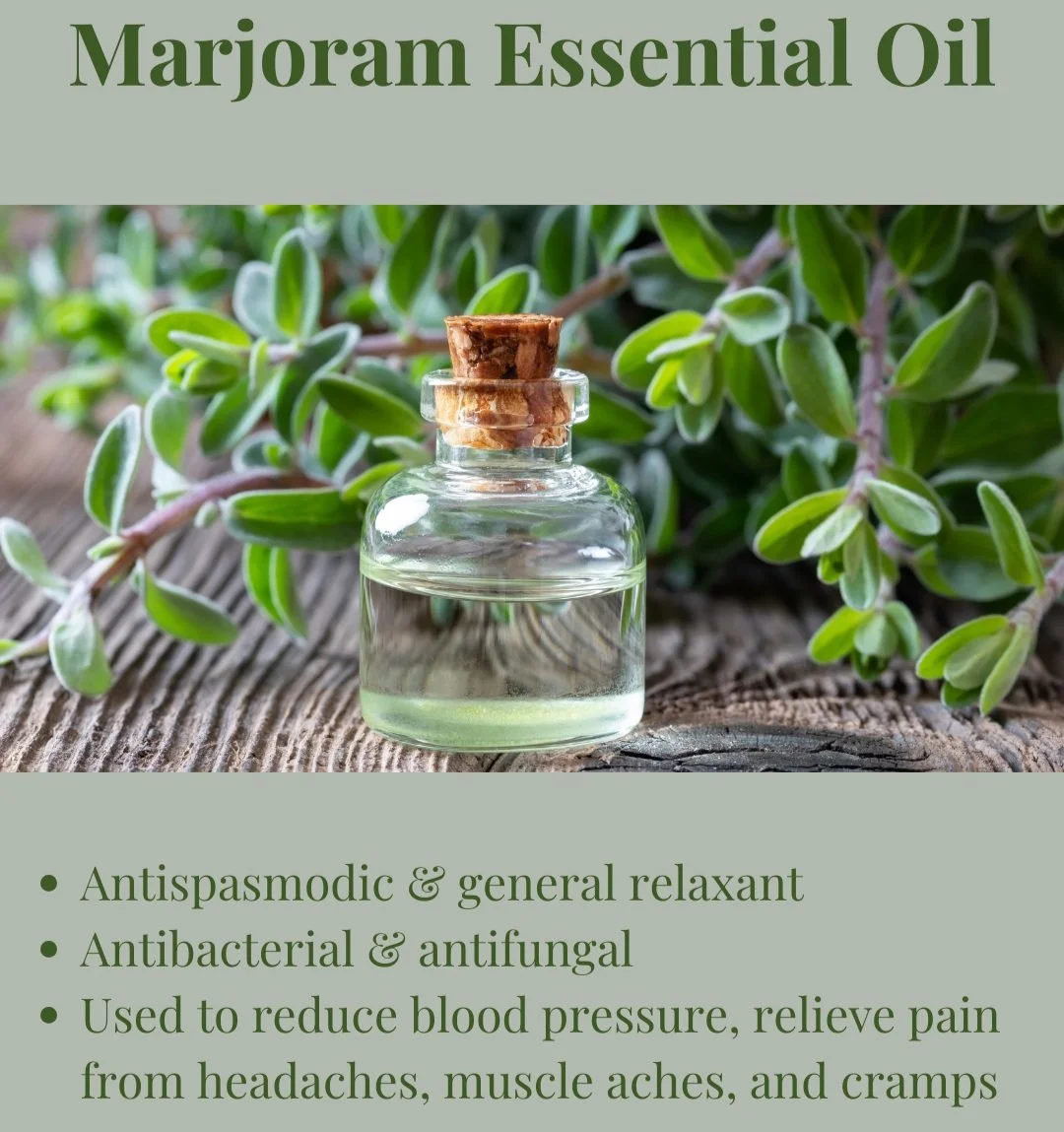Marjoram Essential Oil
Marjoram is an herb with a sweet pine and citrus scent and flavors that is closely related to Oregano (and is even used as a replacement for oregano in some areas). In Greece, marjoram was known as the “joy of the mountains” and as the “herb of happiness” by the Romans. I apply marjoram essential oil after wintergreen to the soles of the feet and to the back in the Raindrop Technique.
The Nerdy Stuff
Marjoram is, like Oregano, from the Lamiaceae botanical family and its Latin name is Origanum majorana. It is native to the Mediterranean region, Northern Africa, and Egypt. Most essential oils of marjoram are produced in France and Egypt and are extracted by steam distillation of the leaves. Marjoram has several key constituents that give it its particular properties:
Terpinen-4-ol
This monoterpene also has antibacterial, antifungal, and antiviral properties, as well as being cardioprotective, antihypertensive, antioxidant, and anti-inflammatory. (https://www.sciencedirect.com/science/article/abs/pii/S0367326X2400234X)
alpha-Terpineol
A monoterpenoid alcohol, this has a lilac-like odor and is most commonly used in perfumery and as a food additive for flavoring. (https://pubchem.ncbi.nlm.nih.gov/compound/Alpha-Terpineol)
Sabinene, cis-Sabinene hydrate, & trans-Sabinene hydrate
These are the monoterpene alcohols that give marjoram its “marjoramy” scent and flavor. They have anti-fungal and anti-inflammatory properties and are primarily used in the perfume and flavoring industries. (https://www.sciencedirect.com/topics/nursing-and-health-professions/sabinene) (https://www.sciencedirect.com/science/article/abs/pii/S0305197899000988)
gamma-Terpinene
This is a monoterpene, which is characterized by a light, lemony scent, and is commonly used to flavor food, as well as in perfumes, soaps, and cosmetics for the scent. Gamma-Terpinene is a powerful antioxidant and has antibacterial properties. (https://pubchem.ncbi.nlm.nih.gov/compound/gamma-Terpinene) (https://www.sciencedirect.com/topics/chemistry/gamma-terpinene)
Linalool
A naturally occurring alcohol, linalool has a floral, spicy aroma and has anti-inflammatory, antimicrobial, anticancer, anxiolytic (anti-anxiety), and antidepressant properties. (https://www.sciencedirect.com/topics/neuroscience/linalool#:~:text=Linalool%20is%20an%20acyclic%20monoterpene,treatment%20of%20certain%20neurological%20disorders.)
Linalyl acetate
This is an acetate ester of linalool and has a floral, sweet, fruity smell used frequently in the making of perfumes. It also has analgesic, antispasmodic, anti-psoriatic, and antibacterial properties. (https://pmc.ncbi.nlm.nih.gov/articles/PMC10416234/)
Actions/Properties
Marjoram was used extensively by the ancient Greeks in fragrances, cosmetics, and medicines. It can aid digestive and menstrual problems, and ease muscular and rheumatic pain, respiratory and nervous complaints. Here are some of the medicinal properties of marjoram:
Analgesic
Antioxidant
Antiseptic
Antispasmodic
Antiviral
Antibacterial
Digestive
Diuretic
Antifungal
Laxative
Anti-hypertensive (it can help lower blood pressure)
Nervine (soothing to the nervous system)
Sedative
Emmenagogue (stimulates menstrual flow)
Vasodilator
Expectorant (helps expel mucus in the lungs)
Using Marjoram Essential Oil
As usual, let’s start with safety. Generally, marjoram essential oil is non-toxic, non-irritating, and non-sensitizing. However, it should still be avoided during pregnancy.
In the Raindrop Technique, I apply it to the soles of the client’s feet and to their back. On their back, I use a circular motion with my palms to gently massage the oil into the muscles along the back.
At home, marjoram essential oil can be used externally to help relieve muscle and joint pain and stiffness, ease constipation and flatulence, help stimulate menstrual flow, soothe headache and migraine pain, lower blood pressure, and generally act to relieve tension, stress, and insomnia. I would recommend diffusing marjoram essential oil or rubbing a small amount diluted with a carrier oil on the chest to help with respiratory problems such as asthma, coughs, bronchitis, and colds.
Sources
Encyclopedia of Essential Oils: The complete guide to the use of aromatic oils in aromatherapy, herbalism, health and well-being. Julia Lawless. Thorson’s Publishing, 2012.
Essential Oils Pocket Reference (6th ed.). Life Science Products and Publishing, 2014.
https://www.sciencedirect.com/topics/agricultural-and-biological-sciences/methyl-salicylate

